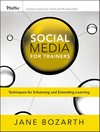THIAGI GAMELETTER:
April 2011
SERIOUSLY FUN ACTIVITIES FOR TRAINERS, FACILITATORS,
PERFORMANCE CONSULTANTS, AND MANAGERS.
TABLE OF CONTENTS
Masthead
Our mission statement, copyright notice, and cast
of characters.
Game Design
Rules for Rules
How to write effective rules.
Puzzle
Give Me A Hint
Adjust the difficulty level.
Guest Gamer
An Interview with Warwick John Fahy
His specialty is learning through
laughter.
Closer
Whose Words Are Next? by Warwick John Fahy
An improv game incorporating key learning
points.
Jolt
Do You See What I See? by Tracy Tagliati
It's all a matter of perspectives.
Improv
Points of View by Tracy Tagliati
Rashomon revisited.
Say It Quick
Ask Stupid Questions by Brian Remer
New subjects and familiar subjects.
Discoveries
The Y-Ball Reviewed by Brian Remer
It has magnetic possibilities.
Ideas
Exploration and Chance by Brian Remer
Exploration through unstructured
play.
Activities
Get Busy and Play by Brian Remer
Stress relief through aimless
exploration.
Zurich Workshops
Thiagi and Sam in Zurich
Public workshops in Europe.
Single Topic Survey
The Pros and Cons of Social Media at Work by Tracy Tagliati
Should I tweet this?
Survey Results
The Global Classroom Paradox by Tracy Tagliati
A summary of your responses.
Check It Out
Twitter Revisited
Debriefing tweets.
Masthead
THIAGI GAMELETTER:
SERIOUSLY FUN ACTIVITIES FOR TRAINERS, FACILITATORS,
PERFORMANCE CONSULTANTS, AND MANAGERS.
Mission
To increase and improve the use of interactive,
experiential strategies to improve human performance in an
effective, efficient, and enjoyable way.
Editorial Roster
 Author and Editor
: Sivasailam (Thiagi) Thiagarajan
Author and Editor
: Sivasailam (Thiagi) Thiagarajan
 Assistant Editor
: Raja Thiagarajan
Assistant Editor
: Raja Thiagarajan
Associate Editors: Tracy Tagliati
Contributing Editors: Brian Remer and Matthew Richter
Editorial Advisory Board: Bill Wake, Matthew Richter, Samuel van den Bergh, and <type your name here>
Copyright Info
The materials in this newsletter are copyright 2011 by The
Thiagi Group. However, they may be freely reproduced for
educational/training activities. There is no need to obtain
special permission for such use as long as you do not
reproduce more than 100 copies per year. Please
include the following statement on all reproductions:
Reprinted from THIAGI GAMELETTER. Copyright © 2011
by The Thiagi Group, Inc.
For any other use of the content, please contact us (
thiagi@thiagi.com ) for permission.
Subscription Info
To sign up, or to donate and help us continue this
newsletter, please see the Online
Newsletter page on our website (
http://thiagi.com/pfp.html ).
Feedback Request
Thiagi believes in practicing what he preaches. This is an
interactive newsletter, so interact already! Send us your
feedback, sarcastic remarks, and gratuitous advice through
email to thiagi@thiagi.com . Thanks!
[Table of Contents]
Game Design
Rules for Rules
The success of a game depends to a large extent on the way
its rules are presented. Here are a few thoughts about the
presentation of written rules:
Keep a consistent point of view. Write your
rules as a set of instructions for the facilitator.
Don't confuse the reader by shifting from facilitator
instructions to player instructions. Give instructions instead
of describing what is going to happen.
Present the rules in a chronological order.
Start at the beginning of the game (“briefing”) and end
with post-game activities (“debriefing”).
Break the rules into small, consistent
steps. Make sure each rule deals with a single
activity or decision. Stick to the same level of detail in
presenting different rules.
Begin each rule with a summary sentence.
Print this sentence in bold letters. Later, when facilitators
want to quickly refresh their memory, they can scan this
sentence instead of reading the entire paragraph.
Use examples to clarify complex rules. One
picture is worth 10,000 words—and so is a clear
example. Print your examples in italics for ease of
reference.
Don't clutter up the rules with too many
variations. Present a lean set of rules to explain
the play of the game. Use a Variations section to
present instructions on how to adjust the basic game to suit
local constraints and needs.
Provide a summary outline of the rules.
Facilitators can use this job aid during the game and during
its debriefing.
[Table of Contents]
Puzzle
Give Me A Hint
Your first task is to solve this puzzle:
The Last Word
At a recent workshop on how managers can become leaders, we
prepared a list of 10 words related to a common topic. We
added an extra letter to each word and scrambled the letters
(including the extra letter). Here is the resulting
list:
|
|
Word |
Extra Letter |
| 1. |
PRONE |
|
|
| 2. |
LABVER |
|
|
| 3. |
ELMODIGIN |
|
|
| 4. |
AIRSPINING |
|
|
| 5. |
CHANTUEIET |
|
|
| 6. |
SIEVAIRONY |
|
|
| 7. |
VICEINPLUS |
|
|
| 8. |
PROWINDEMEG |
|
|
| 9. |
TOPMISSCITI |
|
|
| 10. |
AHLENIGGCHLCN |
|
|
|
The Last Word -> |
|
<- |
Your Task
Rearrange the letters in each line to form a word. Make
sure that all the words belong to a common category.
There will be one extra letter left over from each line.
Take these 10 extra letters and rearrange them to form
another word. This last word will identify the category to
which all the words in the list belong.
Hints
The solution
Difficulty Level in Puzzles
Some people enjoy puzzles. Others hate them.
The secret of designing an effective puzzle is make sure
that it is at a suitable level of difficulty for the solver.
If your puzzle is too difficult, the solver feels
frustrated. If it is too easy, the solver gets bored.
What makes a puzzle difficult or easy? Part of it depends
on individual differences. You cannot come up with a puzzle
that is at the right level of difficulty for all solvers.
The best you can do is to provide different levels of hints.
This way, the solver can achieve the challenge level that
permits a personal flow.
I use instructional puzzles as homeplay
assignments (in contrast to homework assignments).
Whenever I distribute the puzzle sheets, I also distribute
sets of hints. I explain to the solvers that they can
personalize the difficulty level of the puzzle by using or
ignoring different sets of hints. Even if the solvers cheat
(ever notice that cheat is an anagram of
teach?) by going directly to the solutions, they
review useful information.
If you have not already done it, go back to the beginning
of the article and solve the puzzle. Use the different
layers of hints.
You Have the Last Word
You can design last-word puzzles to review your
instructional content. Here are the steps:
- Prepare a list of key words associated with a common
concept. In our puzzle, the key words are associated with
leadership qualities. Other examples include
characteristics of an effective team, services provided by
our organization, strategies for delighting the customer,
steps in the quality-control process, and components of
ISO 9001.
- Specify a suitable label for the category to which the
key words belong. In this puzzle, we came up with
leadership. Other category labels may include
teams, services, customer,
process, and components.
- Count the number of letters in the category label and
select that many key words from the list. In our puzzle,
leadership has 10 letters. We selected 10 qualities of
leaders from a longer list (leaving out such words as
charismatic, energetic,
ethical, and emotional).
- Arrange the selected words in a random order. Add one
letter from the concept label to each of these words.
Scramble the letters of each word along with the extra
letter added to it.
- Control the difficulty level of the puzzle by the way
you scramble the letters. For example, you can spot the
word inclusive more easily in SIVEINCLUP than in
VICEINPLUS. Adjust the difficulty level to suit your
solvers' abilities.
- Prepare different sets of hints. In addition to the
ones that we have used, you can also give additional
letters in each word and synonyms of different words (for
example, courageous for brave).
- Prepare the prototype version of the puzzle and try it
out on a few people. Make suitable adjustments based on
the solvers' reactions and responses.
- Produce the final version of the puzzle along with the
hints and solutions.
[Table of Contents]
Hints 1
Hints to Last Word
Read the first sentence in the introductory paragraph. All
the words in the list relate to the characteristics of a
special type of person.
Another hint
Here are the extra letters: 1 - R, 2 - L, 3 - I, 4 - A, 5 -
E, 6 - E, 7 - P, 8 - D, 9 - S, 10 - H.
More hints
Back to the puzzle
The solution
[Table of Contents]
Guest Gamer
 Warwick John Fahy is an
author, executive speech coach, and facilitator of learning
in the Greater China Region. He is a Mandarin speaker and
has been working with multinational clients in Asia since
1994.
Warwick John Fahy is an
author, executive speech coach, and facilitator of learning
in the Greater China Region. He is a Mandarin speaker and
has been working with multinational clients in Asia since
1994.
Warwick is a life-long-learner specializing in the art and
practice of executive public speaking, and has recently
published The One Minute Presenter,
an eight-step guide to delivering successful business
presentations in a world of short attention spans.
Warwick coaches Asia's leading senior executives who need
to influence their clients, investors, and board members. In
particular, Warwick helps CFOs working in multinationals who
need to better express their messages to key stakeholders
and to expand their influence and enhance their
credibility.
Warwick can be reached at www.warwickjohnfahy.com or www.oneminutepresenter.com
An Interview with Warwick John Fahy
TGL: Warwick, what is your specialty
area?
Warwick: Executive communication. Executive
retreats with senior managers. Building management
competencies in Chinese young professionals. Helping
professionals prepare for important conference
presentations.
TGL: How long have you been designing and
using games?
Warwick: Since 2005. I tend to think of
myself as a facilitator of learning who helps the participants
arrive at a defined outcome through a range of highly
participatory experiences, which include games and other
facilitation techniques.
TGL: Where do you use games?
Warwick: Mostly during executive retreats and
in communication workshops. I recently designed a card game
that could be used in coaching sessions.
TGL: How do your clients
respond?
Warwick: As I work with executive teams that
are often from very rational and logical backgrounds (like
finance), I tend not to call the activities
games.
Firstly, I set a context covering a specific competency
development area, for example, listening skills or
understanding what type of language should be used at various
stages of a presentation.
While setting up an activity, I always demonstrate what
behavior the game expects from participants so that they can
get straight into the game without thinking and talking too
long about the instructions. I will spend quite some time
before the workshop to prepare my script for the instructions.
Like stand up comedians setting up a joke, I try to deliver
the clearest instructions in the fewest possible words.
After the game, I spend time to debrief extensively so that
the participants can see what competency they were working on
and how they might apply it to their workplace situations.
If I am able to engage with the participants at all these
levels, then they respond well. As a facilitator, I need to be
very alert and active during the game to ensure that all
participants are as engaged as they choose to be.
TGL: What types of games do you use most
frequently?
Warwick: Improv, openers, closers, debriefs,
reflective teamwork activity, and role playing. Since going
through Thiagi's workshop in Singapore, I have been creating
card games, textra games, and other framegames.
TGL: Who are your favorite game
designers?
Warwick: Theatre games from Maria Novelly and
Suzi Zimmerman, numerous improv game designers like Keith
Johnstone and John Cremer, and of course, the James Brown of
game designers, the hardest working game designer,
Thiagi!
TGL: What is your prediction about the future
of games?
Warwick: People want to be more involved in
their learning journey, so games or interactive activities or
whatever name you wish to give them, will continue to become
more important in the adult learning experience.
I would also expect that higher levels of interactivity will
be brought into conferences that have traditionally been a
format where hundreds of people listen to a sage on the stage.
While experts will still be important, participants are
becoming more willing to try out interactive learning
experiences. Event planners need to adjust to this trend.
While it is not my specialty, I would also expect online
gaming and virtual worlds to take a great role in how we (and
our children) learn.
[Table of Contents]
Closer
Whose Words Are Next?
by Warwick John Fahy

Key Idea
This is a closing activity that uses elements of
improvisation to review key learning points from your
training content. It's a great way to review a day's
workshop and to overcome the energy dip that often happens
in the late afternoon.
Additional Learning Areas
Accepting ideas. Learning through laughter. Turning
formality on its head. Exaggeration.
When To Use
Use this activity after all main workshop content has been
covered, or at the end of a day for longer training
sessions. The best use is just before end-of-the-day
formalities such as the wrap-up, distribution of awards, and
evaluation.
Participants
Minimum: 2
Maximum: 20
Best: 10 to 16
Time Requirement
30-40 minutes
Supplies
Strips of paper (cut a piece of A4 paper, first into two
[from top to bottom] and then into strips)
Flow
Stage 1: Participant Content Generation
- Tell the participants you are going to wake them up
after a long day and a big lunch. It is time for them to
become creative writers. But not to worry because the
first task is very simple.
- Hand out 10-20 strips of paper to each
participant.
- Ask them to write down quotations from famous
people, words of wisdom, popular expressions, advice
from their elders or teachers, or any phrase or sentence
that comes to mind. Remind them to keep it legal,
ethical, and moral!
- Allow 3-4 minutes for the participants to write down
their phrases. Remind them to write as clearly as
possible. If you see a lot of people writing single
words, suggest that a phrase is better than a
word.
- Ask the participants to imagine that when they go
back to their offices, one of their colleagues asks them
what they learned from today's wonderful training
workshop. Ask them to write down some key learning
points that stick in their head. Ask them to come up
with words of wisdom they would like to share.
- Allow another couple of minutes. Collect all the
strips and mix them up. Put them into a big bag and give
them a big shake.
Stage 2: Setting the Scene
- Tell the participants that they will have a chance
to stretch their bodies, have a bit of fun, and take
part in a short role-play.
- With your co-facilitator demonstrate the activity as
follows:
We will invite two people onto the stage. Let me
demonstrate with my co-facilitator. Come on up
Rebecca. Now we will take on two roles, for example,
a father and a son (or daughter). What is the
situation? Let's imagine that the father is giving
his daughter some advice.
Then take two or three strips of paper per person,
but don't look at them. Spend the first 30 seconds to
build up the scene in the roles. For example say,
My dear daughter, it's so nice of you to come home
over during the holidays. I have been wondering how
you have been doing at University.
Your “daughter” may reply,
Yes, father. It's seems like such a long time. And,
you know, there is something I have been meaning to
ask you.
At this point, the “daughter” pulls up a strip
of paper and reads whatever phrase has been written on
the strip. The chances are the phrase will be
something unusual, like Flowers always bloom in
spring. The “father” has to accept this
phrase as though it totally makes sense and continue
with the conversation.
That's right, dear daughter. The flowers do always
bloom in spring and did I ever tell you what I did
last spring?
Then the father pulls out a strip of paper and reads
the phrase.
- The facilitators should demonstrate this
conversation for about a minute so that participants
firstly see that it will be fun and also that they
understand how to accept and create suspense by using
the unknown phrases on the strips of paper.
Stage 3: Participant Involvement
- Ask for two volunteers and off you go. For the first
couple of rounds, keep it quick, fun and use lots of
praise to encourage the participants. End on a high when
the audience members are laughing.
- After a couple of rounds, ask the audience for
suggestions on who the roles can be. They will usually
pick characters where there is a natural tension such as
boss-subordinate, father-son, older brother-younger
brother, and so on.
- Run the activity until you have given everyone a
chance to participate.
Stage 4: Debrief
Highlight the key learning points that came out. Ask if
there were any other important learning points from the
day that were not mentioned.
Finish by praising the participants' great energy, acting
ability, and commitment to make learning such fun and full
of laughter. This activity will energize the group and you
are now ready to move onto the closing elements of your
workshop.
Variations
Interaction and complexity. While this
activity is most often used in pairs, if you have some
strong performers you can increase the interaction and
complexity by having three participants on stage. Keep the
settings within appropriate boundaries but adding a little
tension between the characters helps to make the scene even
more hilarious. For example, you can involve a manager
deciding between two candidates for a promotion. Or someone
selling his car to two potential buyers. Or a man asking a
father for his daughter's hand in marriage. Or the daughter
asking…. Use your imagination and judgment on this
and make sure the context fits with the culture (of both the
company and country) of your participants. Ask for
suggestions from the audience as much as possible.
Pace. This activity works best when the
scenes are kept short and sweet and the switch between
participants is fast.
Tone. Be very encouraging and supportive
of the actors while they are on stage. In your debrief,
praise them for their acting ability—although at the
time they will not realize they are acting. By having the
script in the form of strips of paper, each person has a way
out when they are stuck on what to say.
Structure. Keep the format the same for
each pairing. Vary the characters and settings. If you have
a pair of strong performers, you can add another
characteristic (like one of them loves to laugh all the time
or stand on one foot). Again ask the audience for their
suggestions.
Why This Works Well
The strips of paper provide a great release and allow
people to laugh and have fun at normally formal
relationships. People love to hear their phrases being read
out. At the same time the inserted phrases from the workshop
allow key messages to be reviewed in a highly entertaining
fashion. As the facilitator, make sure you add a few of your
own phrases and key learning points. Best of all, the
content and performance is all generated by the
participants.
[Table of Contents]
Jolt
Do You See What I See?
by Tracy Tagliati

If you like this jolt as much as I do, you may want to check
out The Systems Thinking Playbook, by
Linda Sweeny and Dennis Meadows. They share a variety other
learning points and different examples of how to use this
activity.
Synopsis
Participants look at an item by viewing it through a small
opening that is held at an arm's length from their face.
Next, they look at the same item, but this time with the
hole closer to their face.
Purpose
To demonstrate how different perspectives can influence our
awareness, objectivity, and ability to solve problems.
Topics
- Problem-solving
- Diversity awareness
- Overcoming boundaries
- Benefits of keeping an open mind
Participants
One or more.
Time
3 minutes for the activity, 5 minutes for the
debriefing.
Flow
Ask participants to make an opening with their
fingers. Demonstrate how to do this by touching
the tip of your index finger with the tip of your thumb.
Focus on an item. Ask the participants to
keep the opening they created with their index finger and
thumb while they fully extend their arm. Then ask the
participants to squint so that are only looking through the
opening and focusing on a specific object.
Take note of what is seen. Ask the
participants to make a mental note of all the details that
they can see from this vantage point.
Change perspectives. Now, ask the
participants to move the opening they made with their index
finger and thumb so that it is close to their face. Ask them
to look at the same object as before.
Take note of what is seen. Ask the
participants to make a mental note of all the details they
can see from this new vantage point.
Debrief. Ask the participants how the
different distances affected their perspectives. Point out
that the specific object they were focusing on did not
change. The only thing that changed was how they viewed the
object.
Conduct a debriefing discussion by asking these types of
questions:
- When would it be beneficial to see an object (idea)
from a close-up and detailed position?
- When would it be beneficial to see an object (idea)
from a wider and broad position?
- How do these shifts in perspective relate to the
workplace?
- How do we know if people we are working with share the
same point of view as we do?
- Is it better to have multiple points of view or a
single one?
- What are the consequences of adopting a narrow point
of view?
Learning Points
People do not always notice the same thing even when they
are looking at the same object. This commonplace observation
has some profound implications for the way we solve
problems, appreciate cultural diversity, accept individual
differences, and adopt new ideas.
[Table of Contents]
Solution
Solution to Last Word
1. OPEN, 2. BRAVE, 3. MODELING, 4. INSPIRING, 5. AUTHENTIC,
6. VISIONARY, 7. INCLUSIVE, 8. EMPOWERING, 9. OPTIMISTIC, 10.
CHALLENGING
Last word (formed from the extra letters): LEADERSHIP
Back to the puzzle
[Table of Contents]
Improv
Points of View
by Tracy Tagliati

This activity works nicely as a follow-up activity to this
month's jolt Do You See What I See?
Purpose
To demonstrate how different perspectives influence our
awareness, objectivity, and ability to solve problems.
Participants
Any number.
Time
5 to 10 minutes.
Supplies
A short scenario (see example below).
Flow
Read a short scenario. Read a scenario
from the point of view of one of the key characters involved
in the incident.
The sample scenario given below is from the point of view
of Brittany, an airline passenger who lost her cell
phone.
Rewrite the scenario. Encourage the
participants to recreate the story from the point of view of
a different character involved in the same incident.
In the sample scenario, you can encourage the
participants to retell the story from the point of view of
Oscar, the airline employee or Michael, Oscar's
manager.
Retell the scenario. Invite different
participants to tell their versions of the stories.
Debrief. Conduct a discussion around the
differences and similarities in the stories. Also discuss
why the stories change depending on who recalls the
incident.
Sample Scenario: The Case of the Lost Cell
Phone
Cast of Characters
- Brittany — an airline passenger
- Oscar — Customer service agent in the Lost
and Found department
- Michael — Oscar's Manager
I arrive at my hotel and realize I left my cell phone on
the plane. I am very upset. I call the airline's lost and
found department. The customer service agent, Oscar,
searches his department and confirms that he has found my
phone. I am relieved. I take a $50 taxi ride back to the
airport . When I arrive, Oscar has gone home. The on-duty
manager, Michael, searches for the phone, but after 30
minutes he is still unable to locate it. He calls Oscar at
home and discovers the cell phone found earlier actually
belonged to another passenger. I am disappointed and upset
with the airline for misleading me. The manager apologizes
and reimburses me for the taxi fare. I am still disappointed
but somewhat consoled.
[Table of Contents]
Say It Quick
Ask Stupid Questions
by Brian Remer
In this issue you'll learn about a nuance of the creative
process beginning with this 99-Word story about curiosity.
Ask Stupid Questions
“Why is the light switch in the hall outside and not in
the bathroom itself?”
Amused by the “obvious” simplicity of the query, our
Basque friend replied, “To avoid electric shocks, of
course!”
This is the beauty of cultural exchange. You get used to
asking stupid questions. Then, back in your own culture, you
continue asking questions that you would have considered
stupid before.
Often, when new to a subject we are too ignorant to know
what questions to ask. But when a subject is familiar, we
know too much to consider asking questions at all!
[Table of Contents]
Discoveries
The Y-Ball Reviewed
by Brian Remer
Roger von Oech's Y-Ball is a skeletal truncated icosahedron
and even if you can't pronounce it, you'll definitely want to
play with it. Just pick up the Y-shaped pieces and begin
clicking them together at their magnetized ends. In moments
you'll have in your hands a familiar structure of interlocking
pentagons and hexagons and realize you've built a soccer
ball!
The Y-Ball is the latest addition to Roger von Oech's
collection of creativity tools and books which includes
A Whack on the Side of the Head,
Ball of Whacks, and the
X-Ball, to name just a few items.
Like the Ball of Whacks and the X-Ball, the Y-Ball is a set of
30 magnetized pieces that can be used to construct an endless
array of figures, shapes, and designs. It comes with a 96-page
book with designs to copy, activities to stretch your
creativity, and explanations that describe how the Y-Ball was
created.
But the Y-Ball is plenty of fun by itself—without
being the stimulus for your next brilliant idea. Pick it up
any time you have an idle moment and have some fun. I keep
mine on the living room coffee table where it provides relief
from inane TV commercials. My desk is another obvious
place—except I would probably find myself distracted by
the Y-Ball's engaging possibilities.
Perhaps a warning is in order for this creativity toy: If you
can put it down, be careful where you leave it because you'll
soon find yourself drawn back by its magnetic
possibilities.
[Table of Contents]
Ideas
Exploration and Chance
by Brian Remer
Playing with the Y-Ball is a constant exercise in creativity.
Once in your hands, you'll find yourself participating in two
important aspect of the creative process: exploration and
chance.
Because the pieces can “snick” together in so many ways,
you often end up making something you didn't expect. Garb two
pieces and match them up just to see how many different ways
they can stick to each other. Think you've got that figured
out? Add another piece and see how the connections and
dynamics change as the magnetic polls attract and repel in
unexpected ways. Make a series of shapes from four pieces. How
will these clones connect? Soon you've invented a surprising,
new object or perhaps you are looking at a previous creation
from an unexpected angle! Whatever happens, eureka! The Y-Ball
invites exploration.
If your intention is to recreate a specific shape, you may
easily become distracted from your goal. Connect several
pieces and you might discover they didn't match up the way you
expected. But the shape they snapped into is still intriguing
and suggests a different idea you'd like to try. Pursue that
new avenue and you'll likely find you have turned down a
previously unseen alley with unexpected possibilities. Chance
encounters and linkages have helped you invent something you
didn't realize was possible. Again, eureka!
The Y-Ball demonstrates how free, unstructured play can be a
form of exploration and how chance can produce outstanding
results when enough pieces are at hand and ready to be
connected. The 99-Word Story for this month emphasizes this
link between exploration and chance. Exploring new cultures,
we collect pieces of information that lead to chance
discoveries back in the familiar territory of home.
When you discover ways to capitalize upon exploration and
chance to become more inventive, please share them (email Brian)!
[Table of Contents]
Activities
Get Busy and Play
by Brian Remer
The Y-Ball is a fun toy. Combine it with von Oech's Ball of
Whacks or X-Ball and the possibilities for creative fun expand
exponentially. Pieces for all three toys can be interchanged
to make new designs because they are all based on the same
mathematical formulae.
But if you are looking for even more possibilities, try
playing with von Oech's pieces on a vertical surface like a
file cabinet or a flat horizontal surface like a cookie sheet.
What other magnetized puzzles or toys are at hand? Bottle
caps, paper clips, and bits of ferrous metal might also create
possibilities. Can they be used with the Y-Ball in unexpected
ways?
Give yourself the luxury of a few moments to both explore and
respond to chance. You don't need a Y-Ball or anything else
magnetic, just an attraction to what you find nearby. You also
don't need to take a lot of time. Even a few moments can be
the perfect stress relief or transition to a new, more
creative frame of mind.
[Table of Contents]
Zurich Workshops
Thiagi and Sam in Zurich
 Van den
Bergh Thiagi Associates are happy to offer their tenth annual
workshops in Winterthur, Switzerland (near Zurich).
Van den
Bergh Thiagi Associates are happy to offer their tenth annual
workshops in Winterthur, Switzerland (near Zurich).
Workshop 1: Interactive Training Strategies
June 21-23, 2011 (three days)
This workshop is designed for trainers, instructional
designers, facilitators, managers, and performance
consultants. The workshop helps a wide range of
practitioners, from newcomers to experienced specialists, to
master skills and concepts related to different types of
training games, simulations, and learning exercises.
This workshop practices what it preaches. Participants
learn new principles and procedures and apply them to
creating and conducting different types of learning
activities that meet their training objectives, audiences,
and needs.
Workshop 2: Design Clinic and Advanced Interactive
Strategies
June 24-25, 2011 (two days)
This workshop is designed for participants who have
completed Thiagi's 3-day Interactive Training Strategies
workshops.
The workshop design strongly incorporates the individual
needs of the participants. At present Thiagi suggests the
following three major components:
- A design clinic in which Thiagi and Sam will provide
consultative advice and feedback on interactive training
activities that you are currently designing (or planning
to design).
- Peer review and support that uses structured
strategies to encourage you to present your ideas, plans,
and problems to your fellow participants and receive
valuable feedback and guidance.
- Advanced sessions on interactive strategies and
facilitation techniques. Selected topics will include
facilitating multinational and multicultural groups,
online games, interactive webinars, positive psychology
activities, and intrinsic motivation.
Bonus: The workshop will provide you with
a software package for designing online games and train you
how to use it.
More Information
For more information, please download our detailed brochure (615k PDF)
[Table of Contents]
Single Topic Survey
The Pros and Cons of Social Media at Work
by Tracy Tagliati
 Social media are experiencing explosive
growth in the training industry. Many companies are embracing
Twitter, Facebook, LinkedIn, YouTube, and other social media
as if they were the new overhead projector. They're used to
support learning initiatives, increase brand awareness,
support growth, and connect with customers in a way that
companies were never able to before.
Social media are experiencing explosive
growth in the training industry. Many companies are embracing
Twitter, Facebook, LinkedIn, YouTube, and other social media
as if they were the new overhead projector. They're used to
support learning initiatives, increase brand awareness,
support growth, and connect with customers in a way that
companies were never able to before.
Now you might be thinking, if so many companies find all
these advantages for using social media, why are other
companies banning the use of them altogether? Often they do so
because of possible security breaches, excessive use of
bandwidth, and the huge potential for being a time waster by
cyberslackers.
Obviously, the industry has not come to a consensus about the
use of social media. If they can benefit the company, why not
use them? If employees are wasting time, why allow them? What
do you think?
Poll Question
Do you think it is a good idea to allow social media in the
workplace?

(The poll opens in a new window.)
Open Question
What are your thoughts on the use of social media? How
are you utilizing them and what actions are you taking to
reduce their potential negative impact?

(The survey opens in a new window.)
You may include your name along with your response, or if
you prefer, keep it anonymous.
We asked some of our colleagues and here is what some of them
had to say:
April: My company had issues with
employees accessing inappropriate media in the workplace. As
a result, they have banned all social networking sites.
Sometimes, this becomes extremely frustrating when I need to
research on a topic.
Drew: My company's solution to security
issues has been to set up a community computer in plain
sight that has no restrictions.
Fran: Social medias have a proven track
record for getting new clients at my company, and the
employees are encouraged to access and utilize it as they
see fit.
Kay: My advice to employees is to keep the
personal social networking to a minimum while on the clock.
Don't give the boss a reason to dislike social media and you
won't have to resort to crouching under your desk to check
Facebook on your iPhone.
[Table of Contents]
Survey Results
The Global Classroom Paradox
by Tracy Tagliati
 Last month we asked if globalization has
affected the way you deliver and design training.
Last month we asked if globalization has
affected the way you deliver and design training.
Here is what you had to say:

(Percentages
reflect 44 votes received by March 31, 2011.)
Of those of you who responded, 68% said, “Yes” and 32%
said “No”.
We also asked you what are some of considerations,
challenges, and benefits you have found in the global
classroom. Here is what some of you had to say:
Response 7) We've had some challenges with style
formatting. This is especially true in countries that use
character based lettering and a vertical writing style
rather than alphanumeric and horizontal style. For example,
if you increase the font size in Japanese, the enlarged
character may take on a whole new meaning.
Response 6) When the global learning is an e-learning
course, the regional technology platforms and infrastructure
can be a huge issue. Sometimes, it has been necessary to
write two or more courses to accommodate for this.
Response 2) I naturally talk fast. When I train in a
country where English is a second language, I have to remind
myself to speak slowly, and avoid using idioms, slang, or
references that may not be understood.
See more
readers' responses or add your own.
Thank you for your responses.
[Table of Contents]
Check It Out
Twitter Revisited
A couple of years ago, I wrote about Twitter, highly
recommending that you get your own (free) account and use this
miniblogging tool to post 140-character tweets. Last year, I
wrote about the practical use of Twitter to have a discussion
in the Learning Chat forum.
If you are not on Twitter, you are missing an important
opportunity for enhancing elearning and all other types of
learning.
If you want to learn more about Twitter and other social
media—and their potential impact on
training—read this book by Tony Bingham and Marcia
Conner:

The New Social Learning: A Guide to Transforming
Organizations Through Social Media.
(You can order the book from Amazon.com by clicking on the
image. When you do, we get a small commission.)
Here's a practical how-to book by Joan Bozarth:

Social Media for Trainers: Techniques for Enhancing
and Extending Learning (Essential Tools
Resource)
If you are hesitant about embarking on the twitter adventure,
you could begin by just being a consumer who reads other
people's tweets. Here are some of the people in the training
and facilitation business whom I follow and strongly recommend
that you follow them too:
- Cathy Moore @CatMoore
- Chris Saeger @chris_saeger
- Clark Quinn @Quinnovator
- Daniel Pink @DanielPink
- Greg Williams @gregwilliams123
- Jane Bozarth @JaneBozarth
- Lars Hyland @larshyland
And speaking of people to follow on twitter, I invite you to
follow me @thiagi or Tracy @tracytagliati .
[Table of Contents]
 Author and Editor
: Sivasailam (Thiagi) Thiagarajan
Author and Editor
: Sivasailam (Thiagi) Thiagarajan Assistant Editor
: Raja Thiagarajan
Assistant Editor
: Raja Thiagarajan Warwick John Fahy is an
author, executive speech coach, and facilitator of learning
in the Greater China Region. He is a Mandarin speaker and
has been working with multinational clients in Asia since
1994.
Warwick John Fahy is an
author, executive speech coach, and facilitator of learning
in the Greater China Region. He is a Mandarin speaker and
has been working with multinational clients in Asia since
1994.


 Reprinted from the
Reprinted from the  Reprinted from the
Reprinted from the  Van den
Bergh Thiagi Associates are happy to offer their tenth annual
workshops in Winterthur, Switzerland (near Zurich).
Van den
Bergh Thiagi Associates are happy to offer their tenth annual
workshops in Winterthur, Switzerland (near Zurich).



